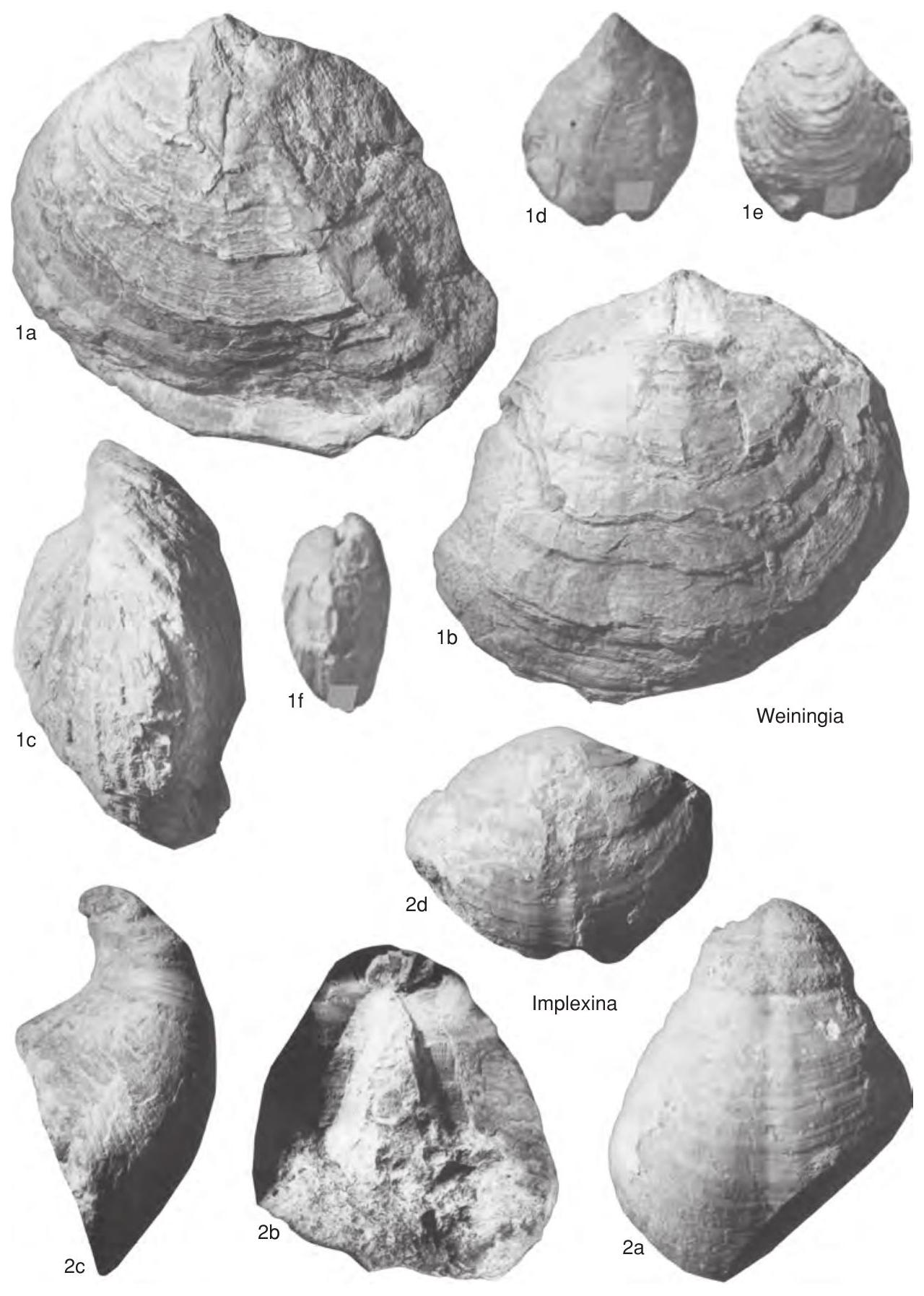Welcome to the Treatise on Invertebrate Paleontology!
Please enter a genera name to retrieve more information.

Weiningia
Classification
Phylum:
Brachiopoda
Subphylum:
Rhynchonelliformea
Class:
Rhynchonellata
Order:
Spiriferida
Suborder:
Spiriferina
Superfamily:
Martinioidea
Family:
Martiniidae
Subfamily:
Martiniinae
Formal Genus Name and Reference:
Weiningia Jin & LIAO, 1974, p. 282
Type Species:
W. transversa, OD
Images
(Click to enlarge in a new window)
Fig. 1150, 1a-c. * W. transversa, Weiningian, Guizhou, China, holotype, ventral, dorsal, and lateral views, X1 (new), ——Fig. 1150, 1 d-f. W. areatus Aleksandrov, holotype, ventral, dorsal, and lateral views, X1 (Aleksandrov & Solomina, 1973)
Synonyms
Elenchus
Geographic Distribution
China (Guizhou), Russia (southern Urals), Japan (Akiyoshi Province)
Age Range
Beginning Stage in Treatise Usage:
Carboniferous (Serpukhovian)
Beginning International Stage:
Serpukhovian
Fraction Up In Beginning Stage:
0
Beginning Date:
330.34
Ending Stage in Treatise Usage:
Carboniferous (Bashkirian)
Ending International Stage:
Bashkirian
Fraction Up In Ending Stage:
100
Ending Date:
315.15
Description
Medium size, subequally biconvex, outline subovate, subtrigonal, or guttate with acuminate ventral beak, hinge line much shorter than maximum width, fold absent, valves evenly convex or with weak sulci in one or both valves, ventral interarea moderately high, triangular, concave, poorly defined, low dorsal interarea variably present, ornament absent except for growth varices and indistinct plications, microornament absent or with weak indistinct capillae, ventral interior with obscure dental flanges, ventral muscle scars deeply incised, in 2 distinct pairs, separated by low median ridge, dorsal interior with large cardinal process, thick crural bases, and median ridge, both valves greatly thickened by callus, vascular impressions pinnate.
References
Museum or Author Information
Classification
Phylum:
Brachiopoda
Subphylum:
Rhynchonelliformea
Class:
Rhynchonellata
Order:
Spiriferida
Suborder:
Spiriferina
Superfamily:
Martinioidea
Family:
Martiniidae
Subfamily:
Martiniinae
Formal Genus Name and Reference:
Weiningia Jin & LIAO, 1974, p. 282
Type Species:
W. transversa, OD
Images
(Click to enlarge in a new window)
Fig. 1150, 1a-c. * W. transversa, Weiningian, Guizhou, China, holotype, ventral, dorsal, and lateral views, X1 (new), ——Fig. 1150, 1 d-f. W. areatus Aleksandrov, holotype, ventral, dorsal, and lateral views, X1 (Aleksandrov & Solomina, 1973)
Synonyms
Elenchus
Geographic Distribution
China (Guizhou), Russia (southern Urals), Japan (Akiyoshi Province)
Age Range
Beginning Stage in Treatise Usage:
Carboniferous (Serpukhovian)
Beginning International Stage:
Serpukhovian
Fraction Up In Beginning Stage:
0
Beginning Date:
330.34
Ending Stage in Treatise Usage:
Carboniferous (Bashkirian)
Ending International Stage:
Bashkirian
Fraction Up In Ending Stage:
100
Ending Date:
315.15
Description
Medium size, subequally biconvex, outline subovate, subtrigonal, or guttate with acuminate ventral beak, hinge line much shorter than maximum width, fold absent, valves evenly convex or with weak sulci in one or both valves, ventral interarea moderately high, triangular, concave, poorly defined, low dorsal interarea variably present, ornament absent except for growth varices and indistinct plications, microornament absent or with weak indistinct capillae, ventral interior with obscure dental flanges, ventral muscle scars deeply incised, in 2 distinct pairs, separated by low median ridge, dorsal interior with large cardinal process, thick crural bases, and median ridge, both valves greatly thickened by callus, vascular impressions pinnate.
